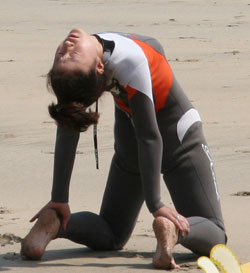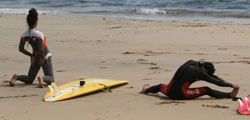Since grade school P.E. class you’ve been told to “always stretch before any type of physical activity.” While in principle this is sound advice, the way you stretch may not be as useful as you’ve been led to believe.
For most people, stretching involves moving a muscle into an elongated position and holding it there for 30 to 60 seconds. Technically this is called “static stretching,” but recent research shows it provides minimal injury prevention at best and, at worst, can actually decrease athletic performance.
 What’s the point?
What’s the point?
Before any sports activity, it’s important to understand what you are trying to accomplish by stretching. Many times you want to prepare your body for explosive dynamic movement. Groups of muscles need to be properly activated, so they are ready to forcefully contract and relax in a rapid, coordinated manner that will bend, twist and propel your body to meet the demands of the sport.
Since all of this movement is orchestrated by your nervous system, it is essential to get that fired up too, communicating well with your muscles. Simply pulling on some muscles for a few minutes just does not prepare you for dynamic movement.
Furthermore, static stretching has a sedating effect on your nervous system, actually causing drowsiness and decreasing your reaction time—obviously not a good combination prior to hopping on that surfboard or mountain bike.
Length Matters
Stretching should be done via movement to prepare your body for the activities ahead. Begin by rotating and articulating all of your major joints—ankles, knees, hips, spine, shoulder, elbows, wrists and neck. Start gently and slowly increase the force and range of motion as the joints start moving more freely.
 You are striving to establish normal muscle length through a natural range of motion. Muscles have an optimal functional length and work synergistically in groups to produce movement around joints. Actively moving joints through a range of motion helps your nervous system correctly set muscle lengths within the groups.
You are striving to establish normal muscle length through a natural range of motion. Muscles have an optimal functional length and work synergistically in groups to produce movement around joints. Actively moving joints through a range of motion helps your nervous system correctly set muscle lengths within the groups.
Another pitfall of pre-game static stretching is the habit of targeting one or two muscles in a group, which over-lengthens them in relation to the others. This ultimately disrupts the group’s ability to produce efficient movement and inhibits sports performance.
Once free motion around the joints is established, you should engage in light movement patterns that mimic the activity you will be doing; start off easy and gradually increase to the intensity you would use for the sport. For example, if you’re going surfing, this might include squats, lunges, trunk-twisting and even going through the “pop-up” movement.
For running or biking, you can actually start the activity at a very low intensity for the first five or 10 minutes and gradually increase to your desired level. You should avoid moving in ranges far beyond what you actually need for the sport. A common misconception is that muscles should be really stretched out and loose when, in actuality, certain muscles need to be shorter and tighter as they provide stabilization during movement.
Static stretching is an important technique, but it is most useful at the end of your sporting activity. Correctly applied to the muscles that were frequently contracted, static stretching can help prevent those muscles from becoming chronically shortened and help to release built-up lactic acid, thus reducing muscle soreness.
For further information, the author can be reached at info@somatic-systems.com.




